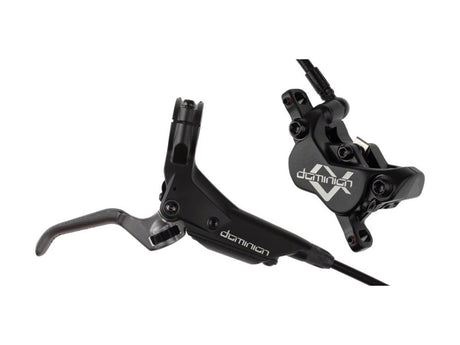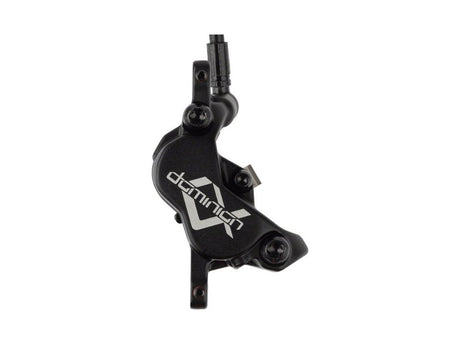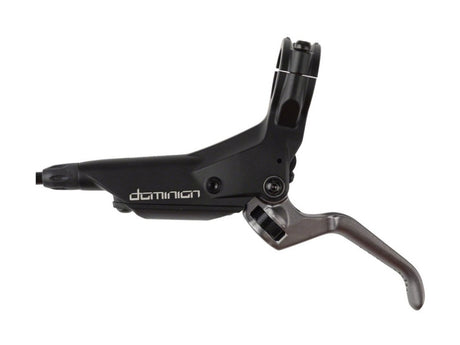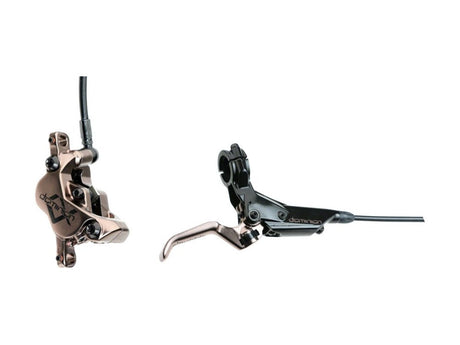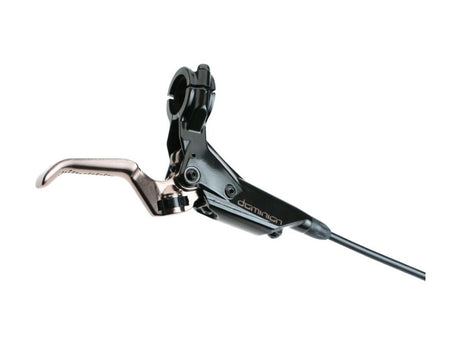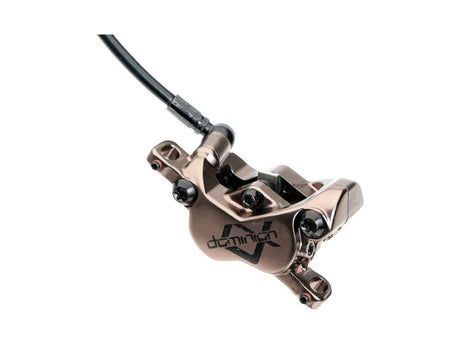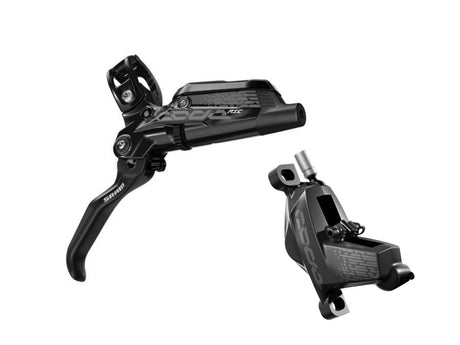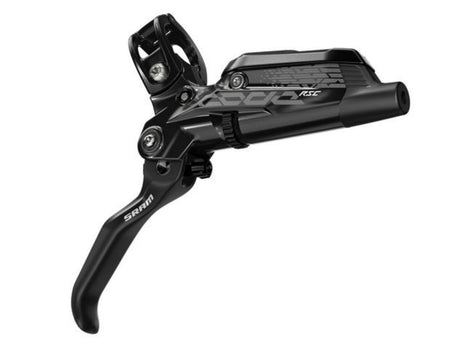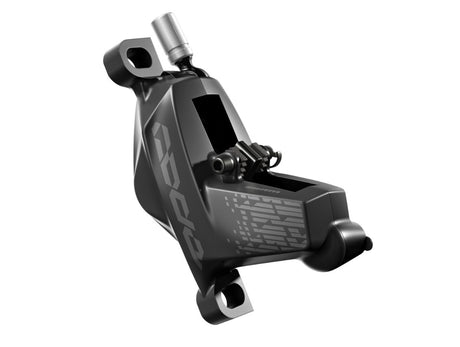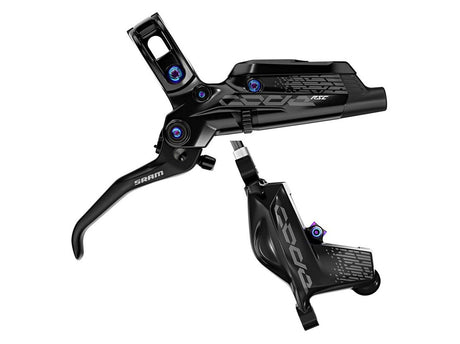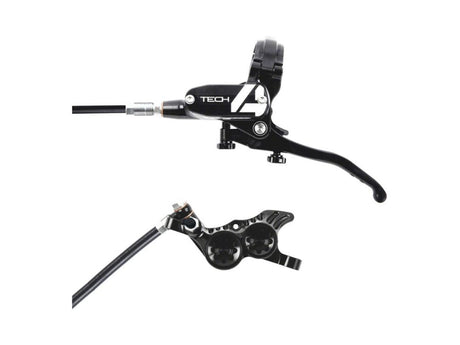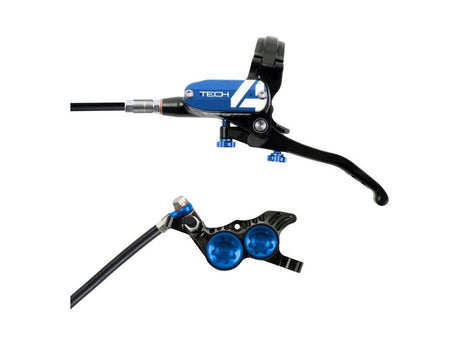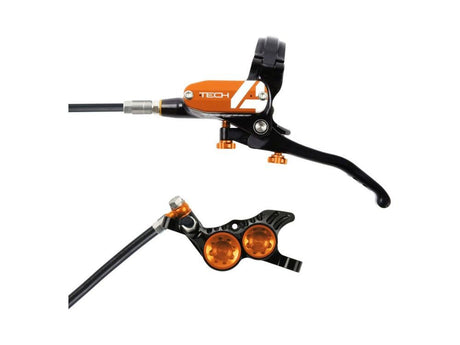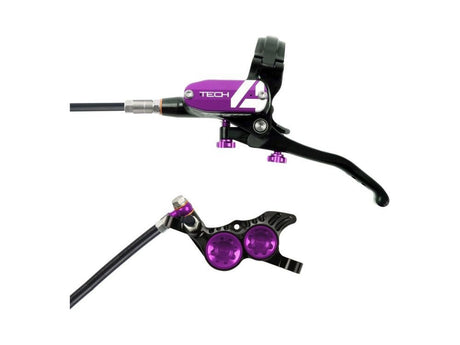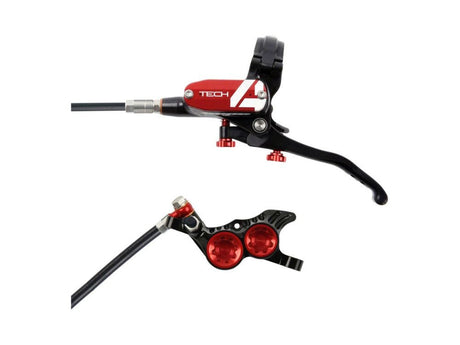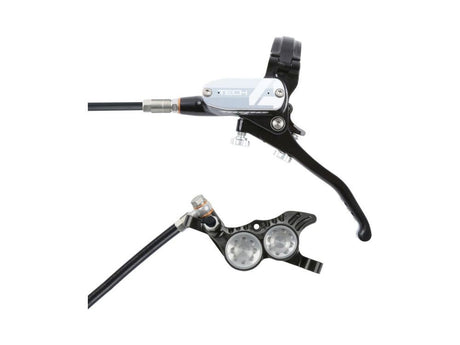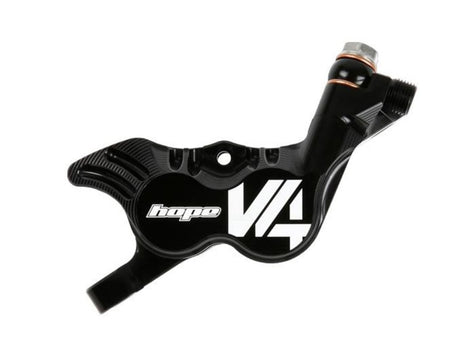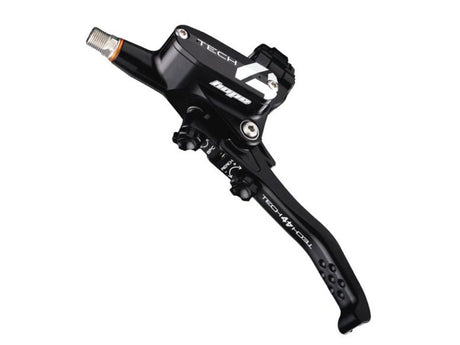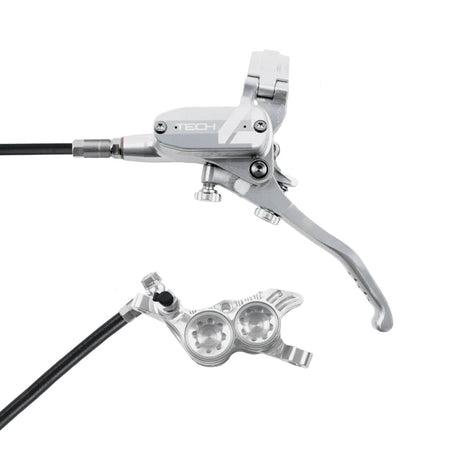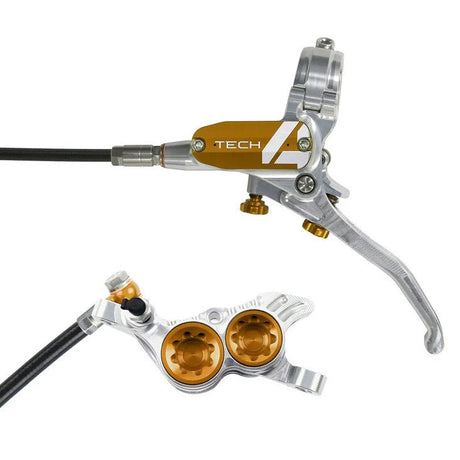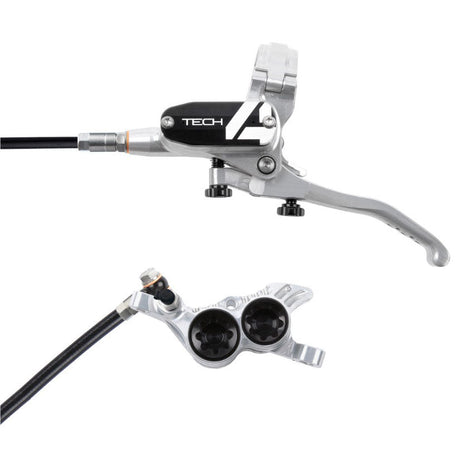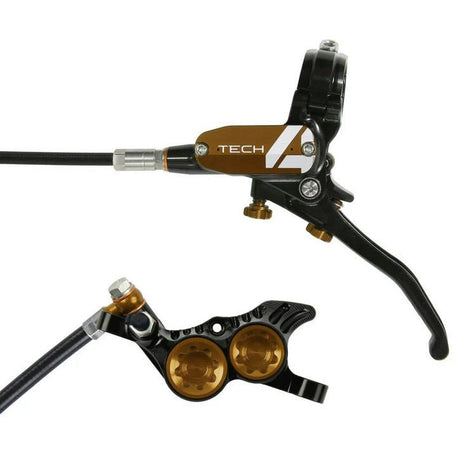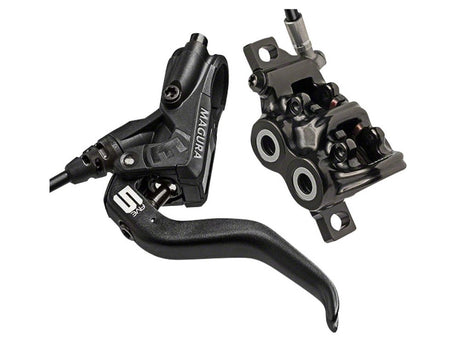Watch this video or read blog post below:
Brakes on your mountain bike are important and often taken for granted. However, if you didn’t have them you’d go careening through the woods and bouncing off trees. The plus side is that you might make it onto Pinkbike's Friday Fails video, but the negative aspect is you might, ya know, break your arms. Mountain bike brakes come in two typical varieties: 2 piston and 4 piston. In this post I’m going to explain the differences between the two and then help you decide which type is best for you!
2 PISTON vs 4 PISTON BRAKE TECH
There's a lever connected to a hose, connected to a caliper.
When you pull the brake lever, there’s a small piston or plunger inside of the lever that forces fluid through the hose and into the caliper. When fluid is pushed into the caliper, the pistons push outward squeezing the brake rotor and will slow down your bike. However, not all brakes have the same amount of stopping power, and most of the difference in power is determined by if a brake caliper has 2 pistons or 4 pistons. Now lets take a closer look at a brake caliper.
A 2 piston caliper has 1 piston on each side, and a 4 piston caliper has 2 pistons on each side.
Since 2 pistons are wider than 1, the brake pads are also typically wider which means the brake pad’s surface area is larger, creating more friction and more stopping power. But overall, 4 pistons squeezing a rotor results in more power than 2 pistons squeezing a rotor. So yes, 4 piston brakes naturally have more stopping power than 2 piston brakes and are overall better while descending. But there’s more to it than that!
Mountain Bike Brake Lingo
Brake Fade is a term commonly used to describe a brake’s loss of power, or fade, while under heavy use. 4 piston calipers are physically bigger to fit the extra piston, meaning there’s space for more fluid inside. More physical material and more fluid means they shed heat much better than a smaller 2 piston caliper, don’t get as hot on descents, and have less loss of power, or less fade.
Modulation is another term used to describe how well you can control the brake’s power output. Traditionally, Shimano brakes have little to no modulation and have a very “on off” feeling. When you pull the brake lever, it’s nearly at full power. On the other hand, SRAM brakes are known for having great modulation. Squeeze the lever a little bit and have a little bit of power. Squeeze the lever a lot and have a lot of power. This makes controlling your speed smoother and easier especially down steep, loose terrain. 4 piston brakes generally have better modulation than 2 piston brakes since the brake fluid is dispersed over more surface area behind multiple pistons.
Rotors are also a key part in decreasing brake fade and increasing modulation. Larger rotors will give you more power and less heat, but your modulation will decrease. This means its just easier to lockup a brake with a 200mm rotor over a 180mm rotor. Also, the lever bodies themselves for 2 piston caliper brakes these days are sometimes a little different than 4 piston caliper brakes, but for the most part the differences in stopping power are due to 4 piston calipers.
Now, a tremendous amount of bikes come stock with 2 piston brakes. Typically 2 piston brakes are cheaper and help keep the price of complete bikes down. This is starting to change recently as many bike manufacturers also realize more and more people are looking to ride aggressive trails, but still most complete bikes under $3,000 out on the trails today have 2 piston brakes. But do you actually NEED to upgrade to 4 piston brakes? Let’s figure that out.
Are 2 Or 4 Piston MTB Brakes Better For You?
If you’re rockin' 2 piston brakes and you feel like your brakes lose power while descending or just straight up don’t have much power from the get go, then you’ll greatly benefit from an upgrade to 4 piston brakes. Plain and simple.
You’ll also be able to ride faster with better brakes! But wait, how can having better brakes make you ride faster? Isn’t their only purpose to slow you down? Well yes. BUT if you have confidence that your brakes will in fact slow you down, you’ll feel more confident to let ‘er rip and ride fast. With those XT M8000’s on steep trails, I was constantly holding the brakes to keep me moving at a more moderate, slower pace because I seriously didn’t think I could grab brake at the bottom of that section to stop me if I was moving quick. After going back to my preferred brakes, the SRAM Codes, I could just totally let off the brakes and carry speed downhill because I knew that at the bottom of that steep bit I could grab a fistful of brakes and slow down REAL QUICK.
But even if you’re in an area that doesn’t have steep, rough terrain like the Pacific Northwest, then a 4 piston brake upgrade still might be a worthwhile upgrade for you. Riding in any area with any vertical descending will be benefited from more powerful brakes. There’s really never a bad time to have more powerful brakes when riding down anything, so even if you’re just going up and down a couple hundred feet then you’ll be happy you’ve got more power to slow you down. Also if you’re a larger person, a more powerful brake will definitely keep your speed in check better.
The only time you just really don’t need 4 piston brakes is if you live in an area with mostly XC riding. 4 piston brakes will be slightly heavier than 2 piston brakes, so if you live in a flat area and mainly ride cross country and don’t need more stopping power, then a 2 piston brake is probably better for you.
And honestly, to really reach and try to find a downside, it would be that 4 piston brake take slightly more maintenance. 2 piston calipers use 2 pistons with 2 seals, and 4 piston calipers use 4 pistons with 4 seals. With more seals, comes technically more seals to clean and maintain. But seriously this is reallyyy reaching to even find a downside.
One thing worth mentioning is that most 2 piston brakes that come stock on complete bikes, and even some 4 piston brakes, will have organic brake pads pre-installed in them. So if you have 2 piston brakes and just want a smidge more power, check to see if you have organic brake pads. If you do, swap those out with metallic pads and you’ll slightly increase your power while descending. If you’re not sure of what you have, you can always email us photos of your brake pad setup and we can help you out. But if you definitely want a noticeable power increase, then let’s get you some brakes!
Which Brakes Should You Get?
Like most bikes and parts, there’s way too many options on the market, but these are our favorite which we personally ride and recommend to all of our customers. We’ll start on the low price points and work our way up to the best of the best.
So if you’re looking to just get some 4 piston brakes on your bike for the lowest price, we would highly recommend the Shimano Deore MT501/MT520. These are $155.99 and are a super simple brake. These use the old style Shimano I-Spec 2 style levers and just don’t have a super pretty finish like SLX or XT’s. These will be the heaviest option, require a tool to adjust lever reach and do not come with IceTech brake pads. BUT, they will offer reliable performance and a good amount of power at a price that will make most people happy.
Now lets move up to what we would consider the absolute best bang for your buck brake, the Shimano SLX 7100/7120. These are $174.99 each, the overall finish is much nicer and they just look and feel like a nicer product. These use the new EV style levers which, this sounds stupid but its true, are stiffer and offer a way better feel than the I-Spec II style levers since they flex less. SLX levers use tool free reach adjust so you can adjust your levers easily and use IceTech brake pads which have heat sink fins to keep the brake’s temperatures down for more consistency. SLX brakes will be more powerful and consistent on long descents versus the Deore due to their new internal re-design to give them the same power as their DH rated Saint brakes.
The next step up from that would be the very well known Shimano XT M8120 which are $209.99 each. These are basically the same brakes as the SLX but with a slightly different finish color and a FreeStroke adjustment which basically doesn’t do anything. The XT’s come in a black box instead of a blue box and say XT on them... and to be honest you’ll probably just want XT brakes if you just want XT brakes.
Now onto our favorite, and what we consider to be the best brake on the market, the SRAM Code RSC. The Code RSC’s sell for $245 each and offer the most power and the most adjustability. The lever not only has tool free reach but also pad contact adjustment, which lets you control where your bite point sits. So when you squeeze the lever and think the lever has too much throw, you can dial up that bite point and make the brakes bite faster. Plus, they’ve got great modulation and you can seriously control your speed with these things. If you’re riding aggressively and you want tons of power and the ability to adjust everything exactly how you like it, then you’re going to be best suited with the Codes.
Summary
Besides the two big "S's" there's a ton of honorable mention of powerful, reliable brakes from brands like Hope brakes, Magura and TRP. The above brakes are just our favorites from what we ride and recommend most often to customers.
2 or 4 piston brakes really comes down to your riding style and the kind of terrain you are riding on. Aggressive, fast, or riding on steeper terrain? 4 Pistons will be your best bet. More cross country oriented? 2 pistons will be best for you.
If you have any questions, please contact us and we'll be happy to answer any questions you've got!

